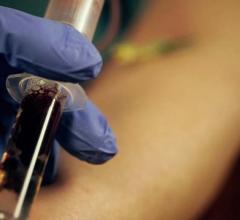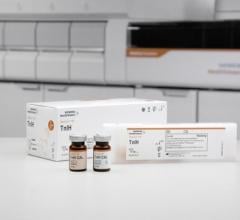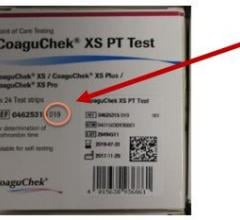
The most recent U.S. Food and Drug Administration (FDA) clearance was Siemens Healthineers high-sensitivity troponin I assays (TnIH) for the Atellica IM and ADVIA Centaur XP/XPT in vitro diagnostic analyzers. The test helps in the early diagnosis of myocardial infarctions without the need for serial tropic testing. The time to first results is 10 minutes.
Troponins are a family of proteins found in skeletal and heart (cardiac) muscle fibers that produce muscular contraction. Troponin T (TnT) and I(TnI) molecules have amino acid sequences that are found only in cardiac tissue. With damage to heart muscle cells, cardiac-specific troponin is released into the bloodstream. Thus, cardiac troponins (troponin I and T) are very sensitive and specific indicators of damage to the myocardium.
Cardiac troponin (cTn) assays were introduced into clinical practice in 1995 as an aid in the diagnosis of acute myocardial infarction (AMI).[1] Guidelines published in 2000, recommended troponin as the preferred diagnostic marker for the first time.[2] Originally, these assays lacked the sensitivity to reliably rule out myocardial infarction for 12 hours or longer after symptom onset using serial blood sampling. Consequently, there has been an incentive, among diagnostic manufacturers, to develop more sensitive and precise troponin assays. Increased sensitivity of these tests has a great benefit, particularly rapid and confident rule-out of acute myocardial injury and the ability to quickly discharge patients in busy emergency departments (ED).
What Does High Sensitivity Troponin Testing Mean?
In order to be clinically usable, early guidelines recommended imprecision limits for cTn assays, imprecision being measured as the coefficient of variation <10% at the 99th percentile upper reference of normal (URL).[2-4] In comparison, the new generation of troponin assays measure cTn concentrations five-fold to 100-fold lower than the early conventional assays. Increased sensitivity means that the assays have much lower limits of detection. The new standard for the highly sensitive cardiac troponin (hs-cTn) assay is defined as the ability to detect cTn concentrations precisely with a coefficient of variation, <10 % at or the below the 99th percentile URL and measurable in >50% of normal healthy individuals (5).
Currently, there are five hs-cTn assays that may meet these criteria.[6] Of these, only Siemens Healthineers, Beckman Coulter and Roche offer hs-cTn assays that are available for sale in the U.S. There is debate whether the Roche fifth-generation hs-cTnT meets the above criterion for a highly sensitive assay.[7]
With older troponin assays, troponin was undetectable below the 99th percentile URL cut-point and any detectable troponin was considered to be abnormal. With the use of highly sensitive assays, many healthy individuals have troponin that is now detectable.
Biomarkers Used in Troponin Testing
There are six mechanisms that have been proposed to explain the release of troponin into the bloodstream:
• Normal cell turnover
• Myocyte necrosis
• Apoptosis, or programmed cell death
• Proteolytic fragmentation
• Increased cell membrane permeability
• Membranous blebs [1]
It is important to note that cTn is a cardiac-specific biomarker, not a disease-specific biomarker. Thus, cTn is a marker of cardiac injury, not merely ischemic damage from an AMI. Elevation of cTn indicates myocardial injury regardless of etiology. Improvements in analytical sensitivity have increased detection of cTn elevations, particularly mild cTn elevation, not only due to AMI, but also because of numerous acute or chronic diseases other than AMI. It is important to distinguish AMI, which requires a rise and/or fall of cTn values, from chronic elevations that are associated with structural heart disease.
The latest guidelines clearly state that serial troponin results are critical for diagnosis, stating “The term acute myocardial infarction should be used when there is acute myocardial injury with clinical evidence of acute myocardial ischaemia and with detection of a rise and/or fall of cTn values with at least one value above the 99th percentile URL …” [4]
Shortening the length of time between serial sampling is a significant advantage of hs-cTn assays for the diagnosis of AMI. Boeddinghaus et al [7] used both one and two-hour protocols to evaluate a new hs-cTnI assay (Siemens Healthineers) and demonstrated a 99.7% and 100% negative predictive value for AMI respectively. Other researchers, particularly those outside the U.S., have studied reducing the time between samples even further. A recent study showed that a single hs-cTn result below the limit of detection had a 99% negative predictive value [8] although this practice has yet to be adopted in the U.S.
What Troponin Testing Can Detect Beyond Heart Attacks
The diagnosis of AMI is no longer restricted to those with a primary coronary event, usually atherosclerotic plaque rupture (MI type 1), but also in those with conditions caused by an imbalance between myocardial oxygen supply and/or demand in the coronary circulation (MI type 2; e.g., coronary endothelial dysfunction, coronary artery spasm, coronary embolism, tachy/bradyarrhythmia, anemia, respiratory failure, hypotension, and hypertension).[3,4] With high-sensitivity cTn assays, the frequency of MI type 2 appears to increase and a rise and/or fall of cTn values on serial testing may or may not be useful in differentiating MI type 1 from type 2.[9] Thus, the clinical features must be considered to differentiate MI type 1 from MI type 2.
Elevation of cTn indicates myocardial injury regardless of its etiology, and does not necessarily indicate the presence of AMI. Improvements in analytical sensitivity have increased the detection of cTn elevations, particularly mild elevations, because of numerous acute or chronic diseases other than AMI. Many of these conditions are listed in current guidelines (4). How to proceed with an outpatient recently discharged after exclusion of AMI, but who has a stable elevation in hs-cTn or a measurable level below the 99th percentile requires careful patient evaluation and thoughtful clinical consideration by cardiologists. For example, evaluation for underlying structural heart disease with echocardiography or cardiac magnetic resonance imaging may reveal underlying pathology.[10] Thus, the “subclinical” disease revealed by using a hs-cTn assay can lead to intensive management and hopefully improve clinical outcomes.
Reducing Costs by Using High-sensitivity Troponin Testing
Due to the increased sensitivity of the new troponin assay, there has been concern that this increased sensitivity could lead to an increase in other diagnostic procedures. In a study by Twerenbold et al [11] researchers found there was not only no increase in angiography, but a significant decrease in the need for stress testing. They concluded that introducing a high-sensitivity troponin assay “…was associated with an improved rule-out process and thereby helped to substantially reduce the need for cardiac stress testing and time to discharge.” Total costs were also reduced.
The Extended Value of High-sensitivity Troponin Testing
Over the past few years, studies have shown that elevated troponin levels provide important prognostic information for patients. It has been consistently shown that an increase in cTn is associated with future adverse cardiac events, illustrating that troponin can be a marker of silent cardiac damage. In an early community-based cohort study, initial conventional troponin I assays were shown to predict mortality and first coronary heart disease event in men that appeared to be free from cardiovascular disease at baseline.[12] With the advent of more sensitive troponin assays, this application has been studied further.
There is a growing body of evidence indicating that elevated hs cTn cardiac troponins have significant prognostic implications among patients otherwise believed to have clinically stable cardiac artery disease (CAD). In two sub-studies of the Prevention of Events with Angiotensin Converting Enzyme Inhibition Therapy (PEACE) trials, both cTnI and cTnT were associated with increased risk of cardiovascular death and heart failure in patients with chronic stable CAD syndromes.[13] Increased risk has been found among asymptomatic patients, not just those who present to the ED with chest pain. In the Atherosclerosis Risk in Communities Study, patients with very low hs-cTn values (well below the 99th percentile limit) had a 2.3-fold risk for mortality and heart failure.[14]
The increased sensitivity of hs-cTn assays translates clinically to earlier detection of myocardial injury, detection of smaller areas of injury, and reduced time for diagnosis. The most significant medical advance that hs-cTn offers is a reduction in time for AMI rule-out. Thus, the introduction of high-sensitivity troponin assays has, and will continue to, improve the standard of care for many patients. If AMI is rapidly ruled out, patients may benefit from early discharge from ED. Additionally, hospitals may find a reduction in costs due to eliminating procedures and reducing length of stay.
The sensitivity of the new hs-cTn assays may also lead to further applications in the future. The use of this biomarker in the early identification of silent heart disease or highly-risk populations may ultimately lead to improvements in the primary prevention of cardiac disease.
Editor’s Note: Linda C. Rogers, Ph.D., DABCC, FACB, is a board-certified clinical chemist. Rogers has held laboratory director positions in Chicago, northwest Ohio, Florida, and Oregon. She has held multiple positions in the laboratory diagnostics industry including clinical and scientific affairs. Rogers areas of special interest and expertise are in the fields of cardiac markers, endocrinology, maternal fetal medicine and women’s health. She has presented papers, spoken at symposia, and organized programs for national and international meetings. Rogers is currently an independent consultant and was compensated by Siemens Healthineers for her time and expertise to author this article.
Related High-sensitivity Troponin Testing Content:
New Heart Attack Evaluation Cuts Unnecessary Tests, Time in ER
Siemens Launches High-sensitivity Troponin Test for Faster Diagnosis of Heart Attacks
More Sensitive Blood Test Diagnoses Heart Attacks Faster
VIDEO: Use of High Sensitivity Troponin Testing in the Emergency Department — Interview with James Januzzi, M.D.
Validation Studies Confirm High Accuracy of Novel HART AI-Driven Blood Tests
Abbott Point-of-Care Blood Test Speeds Heart Attack Diagnosis
Highly-sensitive Troponin Test Can Detect Myocardial Injury After Non-Cardiac Surgery
Florida Medical Center First in State to Offer High Sensitive STAT Blood Test
References:
- Garg P, Morris P, Fazlanie AL, Vijayan S et al. Cardiac biomarkers of acute coronary syndrome: from history to high-sensitivity cardiac troponin. Intern Emerg Med (2017) 12:147–155 DOI 10.1007/s11739-017-1612-1.
- Alpert JS, Thygesen K, Antman E, Bassand JP, et al. Myocardial infarction redefined—a consensus document of the Joint European Society of Cardiology/American College of Cardiology Committee for the redefinition of myocardial infarction, J. Am. Coll. Cardiol. 36 (2000) 959–969.
- Thygesen K, Alpert JS, Jaffe AS et al (2012) Third universal definition of myocardial infarction. Eur Heart J 33:2551–2567. doi:10.1093/eurheartj/ehs184.
- Thygesen K, Alpert JS, Jaffe AS, Chaitman BR, Bax JJ, et al. Fourth universal definition of myocardial infarction (2018). European Heart Journal (2018) 00, 1–33 EXPERT CONSENSUS DOCUMENT doi:10.1093/eurheartj/ehy462.
- Apple FS. A new season for cardiac troponin assays: it's time to keep a scorecard. Clin Chem 2009; 55: 1303-6.
- Vasile VC, Jaffe AS. High-Sensitivity Cardiac Troponin for the Diagnosis of Patients with Acute Coronary Syndromes. Curr Cardiol Rep 2017; 19:92.
- Boeddinghaus J, Twerenbold R, Nestelberger T, Badertscher P, et al. Validation of a Novel High-Sensitivity Troponin I Assay. Clinical Chemistry 64:9 (2018)
- Sandoval Y, Smith SW, Shah ASV, Anand A, Chapman AR, Love SA, et al. Rapid rule-out of acute myocardial injury using a single high-sensitivity cardiac troponin I measurement. Clin Chem 2017; 63:369–76.
- Frederick K, Jaffe AS. Preparing the United States for high-sensitivity cardiac troponin assays. J Am Coll Cardiol 2013; 61(17): 1753-58.
- Bonaca J. Time for a New Strategy for High-Sensitivity Troponin in the Emergency Department. J Am Coll Cardiol 2017; 70 (18): 2237-2239. DOI: 10.1016/j.jacc.2017.09.021.
- Twerenbold R, Jaeger C, Gimenez MR, Wildi K, Reichlin T, et al. Impact of high-sensitivity cardiac troponin on use of coronary angiography, cardiac stress testing, and time to discharge in suspected acute myocardial infarction. European Heart Journal, Volume 37, Issue 44, 21 November 2016, Pages 3324–3332. https://doi.org/10.1093/eurheartj/ehw232
- Zethelius B, Johnston N, Venge P (February 2006). "Troponin I as a predictor of coronary heart disease and mortality in 70-year-old men: a community-based cohort study". Circulation. 113 (8): 1071–8. doi:10.1161/CIRCULATIONAHA.105.570762.
- Islam Y. Elgendy, Carl J. Pepine. High sensitivity cardiac troponin T and I and risk stratification of patients with stable CHD: Is it time to incorporate this in routine clinical practice? Int J Cardiol 250 (2018) 266–267.
- Saunders JT, Nambi V, deLemos JA, Chambless LE, Virani SS, Boerwinkle E, et al. Cardiac troponin T measured by a highly sensitive assay predicts coronary heart disease, heart failure, and mortality in the Atherosclerosis Risk in Communities Study. Circulation 2011; 135: 1367–73.


 October 09, 2019
October 09, 2019 









